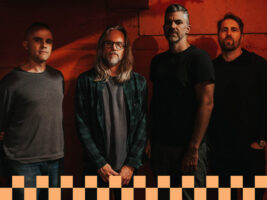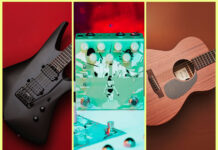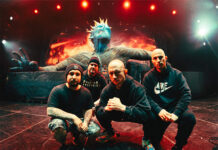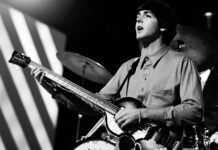
Between the Buried and Me rank their own albums from worst to best
The only band you can wholly compare Between the Buried and Me to is Between the Buried and Me. The Raleigh explorers may have formed with a profound penchant for Converge, the Dillinger Escape Plan and technical metalcore, but they quickly broadened their horizons to unparalleled degrees, consolidating country hoedowns, lounge and myriad other genres into what they do. The quartet have a new album, The Blue Nowhere, coming out in September, so now seemed like an ideal time to take stock and sit down with founding guitarist Paul Waggoner to get a sense of their journey so far.
READ MORE: Five times the Hives were the best band in the world (according to the Hives)
This is every record the band have ever put out, ranked from worst to best by the man who shredded on each one:
10. Between the Buried and Me (2002)
How old were you on the first album?
“It was written when I was 19 years old or something. That was when I had just gotten to a point where I could play the guitar somewhat reasonably well and was able to take what was in my mind and put it on the guitar. Tommy [Giles Rogers, vocals/keyboards] was my musical spirit animal and we vibed out and had a cool chemistry together pretty instantly. The self-titled album is a reflection of that: it’s just us sitting in our apartment in Raleigh, North Carolina and riffing together. We built those songs with Will Goodyear, our original drummer.”
Will didn’t stick around for long after the album came out. What was he like to be in a band with?
“Oh, he’s great! I’m still great friends with him. He’s in a really cool metal band called Valletta, where he plays guitar. He’s incredibly creative, very multi-talented, great drummer, great guitarist, great singer, and a lot of fun to work with.”
How do you weather such a key member leaving the band at such an early age?
“Pure stubbornness, man! ‘I don’t want to do anything else, so I’m gonna keep doing this.’”
Image: Randy Edwards
9. The Silent Circus (2003)
Possibly the most erratic album of the bunch.
“Yeah, it’s a weird record: very grindy and raw. We had Mark Castillo playing drums on that, and he was a fast, fast drummer. We fleshed the record out in a practice space in Raleigh and we were young. We didn’t really know what we were doing. We just wanted to be a – I don’t know what we wanted! There are some really cool riffs. It was an early step in our self-discovery.”
What was it like transitioning from Lifeforce Records to Victory?
“Victory probably became interested because they just saw us gaining a bit of headway in the American market. We signed with Lifeforce because no American label was even remotely interested in what we were doing! All of a sudden, the record did pretty good and we were touring. American labels, particularly Victory, showed some interest. We’re certainly very thankful for that.”
8. Alaska (2005)
This is when you guys started to come into your own musically.
“It’s really the first album where we were getting sort of experimental, starting to incorporate some keyboards. Selkies has a real stretchy guitar solo in it. Autodidact, the whole middle section of that is when Dan’s [Briggs, bass] influence really started coming to the table. You don’t really hear that in your typical metalcore scales or patterns. We started to do some weird shit musically on Alaska but still retained that core metalcore sound. It’s a crowd favourite, our fans love Alaska and would probably like us to play more songs from Alaska. It means a lot to me, but I don’t write music like that anymore.”
What do you mean?
“I just don’t play guitar like that. That was when I was just a metal guy for the most part. As I’ve become older, I’ve found myself influenced and inspired by different types of guitar playing. When I was relearning songs [for a 2025 tour where Alaska was played in full], I was like, ‘Shit, man, I don’t play this fast anymore!’”
Image: Randy Edwards
7. Colors (2007)
A lot of people would put this one higher…
“It’s objectively the most important album in our career, and I think if we hadn’t written that record, we probably wouldn’t be a band anymore. It is the absolute turning point for us, when we establish ourselves as a progressive metal band. The only reason I have it a little lower is that it’s just old. We did it in 2007, we’ve played it a bazillion times live – which I still enjoy, because the fans love it – and the songs are great, but because it’s so old, it doesn’t have the same resonance in my mind.”
Is there an element of fatigue as well? I imagine a lot of fans come up to you and go, ‘Hey, Colors, right?’
“I would maybe call it a subconscious fatigue. It seems to always be the album that people talk about or people want to hear, even now. I love playing Colors but when I really think about, I’m like, ‘Shit, man, that’s almost 20 years ago we wrote that record! Does anybody care about the new stuff?’ I guess that’s a good problem to have.”
6. Automata I & II (2018)
How do you feel about Automata today?
“I think, in hindsight, we would have preferred to release it all as one album, rather than split it up into two. It was written as one long album. It was sort of a decision with the label to release it as two shorter records, but I love the songs. Obviously, Condemned to the Gallows was nominated for a Grammy, so it did well for us. It’s got some great moments, it’s very diverse. It showcases our heavier, more aggro side, as well as some really cool melodic moments. I love the chorus section in Blot.”
You don’t sound thrilled with it being a two-parter.
“I think it would have had more impact if it were released as one whole piece, because that’s how it was written and how it was meant to be listened to. This was an era, and I guess we’re still in that era, where it seemed like the perceived attention span of the average music fan was pretty short. We thought, ‘Maybe we’ll just release two short albums and it’ll resonate more,’ but that was probably a mistake.”
What’s it like being nominated for a Grammy?
“It’s a bit surreal. But, not to be flippant about it, it doesn’t mean a whole lot to us. We don’t take a lot of validation from things like that. We’re a metal band: we just like to play shows and put out records that we’re happy with.”
5. Colors II (2021)
Describe to me the difference between making a sequel to a record versus when you have a blank slate.
“I think people think that we were very mindful about creating a sequel to Colors, when in actuality, we were just hearkening back to the creative headspace we were in during Colors. It was very much a time where we were trying to establish ourselves as being the band who were willing to try new stuff, and we didn’t really care about what genre we fit in. For Colors II, we wanted to relive that mindset.”
But there are lots of moments that reference Colors.
“Yeah, there are a couple little ear-candy moments where we try to recall certain themes. Human Is Hell is an homage to White Walls, a little bit. In general, we approached it as, we were just writing a new BTBAM album, but we wanted to take ourselves back to 2007. I really do like that record, and it’s got some of my favourite BTBAM songs on it.”
4. Coma Ecliptic (2015)
A bit of an underdog in your discography, in my opinion.
“It’s kind of a different record for us: it’s probably our proggiest and easier to digest, a lot of clean vocals. That guitar is almost a supporting instrument. A lot of the songs were written with keyboard or bass as the backbone. It was a roll of the dice for us, but we try to do something different for every record.
“We just did a tour in the States where we played the entire album for its 10-year anniversary and it was a lot of fun. It made me dig back into those songs and realise, the way the instrumentation was orchestrated, it was pretty clever. I’m proud of that record.”
3. The Great Misdirect (2009)
This is a spicy one.
“It’s a spicy take [putting this album this high], but I like the moodiness of it. It’s a darker record, it’s got some wildcard BTBAM moments that we hadn’t done prior, and I just like the vibe of it. It’s got some of my favourite songs, like Disease, Injury, Madness and Fossil Genera.”
What was the mood making it? Was there any pressure making the follow-up to Colors?
“A little bit. After Colors, we established ourselves as a progressive band, whereas before we were a technical metalcore band or whatever. But, the first thing we wrote for The Great Misdirect was that intro, Mirrors, and it’s a haunting, dissonant, diminished-sounding intro. We knew immediately that it was going to have a spin on it than Colors. We just reacted to that and that’s how we ended up writing the rest of the record.”
2. The Parallax II: Future Sequence (2012)
Very much a fan-favourite.
“I can see why. It was a very focussed time in the band’s career: we were coming off the EP [2011’s The Parallax: Hypersleep Dialogues], and it felt like an opportunity to really flesh out those ideas in a full album context. It was, again, a turning point record, I think, where we really honed in on the things that make us who we are.”
How did it end up working that way, with an EP and then a full-length sequel the year after?
“We had just signed to Metal Blade Records and we wanted to put out something relatively quickly. That was the impetus for doing the EP. Once we did that, we were really ready to write a full-length record. The EP served as the beginning phase of writing The Parallax.”
It feels like your boldest undertaking, at least at that point.
“For sure! We embraced the grandiosity of what we were doing. Colors was our first foray into that, but I think Parallax II ramped it up a bit.”
1. The Blue Nowhere (2025)
Every artist says the new one is the best…
“And I’m no different! Obviously, it’s the newest, so it feels the most reflective of where we are in our journey as musicians and as people, but also, I think it’s a very good amalgamation of all our influences. It feels the most evolved and diverse, but it’s still very intentional. It’s a very cool encapsulation of everything that Between the Buried and Me is all about.”
Making something that’s more reflective as a whole, was that a response to Colors II, which zeroed in on one period of time?
“I think when we write a new album, especially this one, it really is just a blank canvas. All bets were off and wherever ideas we had to bring to the table, we brought them. It was all about a fresh start.”
Was that fresh start because of the lineup change? [Rhythm guitarist Dustie Waring parted ways with the band in July, two years after being accused of rape. He denies any wrongdoing.]
“That didn’t really have anything to do with it. I think it was just the four guys that wrote and recorded the new record – that was the core nucleus of the writing and so we worked from there. I don’t think, necessarily, the lineup change influenced the writing at all.”
The Blue Nowhere is out on 12th September via Inside Out Music.
The post Between the Buried and Me rank their own albums from worst to best appeared first on Guitar.com | All Things Guitar.
Source: www.guitar-bass.net












